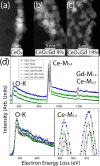Cerium Oxide Nanoparticles with Entrapped Gadolinium for High T 1 Relaxivity and ROS-Scavenging Purposes
- PMID: 35755371
- PMCID: PMC9218977
- DOI: 10.1021/acsomega.2c03055
Cerium Oxide Nanoparticles with Entrapped Gadolinium for High T 1 Relaxivity and ROS-Scavenging Purposes
Abstract
Gadolinium chelates are employed worldwide today as clinical contrast agents for magnetic resonance imaging. Until now, the commonly used linear contrast agents based on the rare-earth element gadolinium have been considered safe and well-tolerated. Recently, concerns regarding this type of contrast agent have been reported, which is why there is an urgent need to develop the next generation of stable contrast agents with enhanced spin-lattice relaxation, as measured by improved T 1 relaxivity at lower doses. Here, we show that by the integration of gadolinium ions in cerium oxide nanoparticles, a stable crystalline 5 nm sized nanoparticulate system with a homogeneous gadolinium ion distribution is obtained. These cerium oxide nanoparticles with entrapped gadolinium deliver strong T 1 relaxivity per gadolinium ion (T 1 relaxivity, r 1 = 12.0 mM-1 s-1) with the potential to act as scavengers of reactive oxygen species (ROS). The presence of Ce3+ sites and oxygen vacancies at the surface plays a critical role in providing the antioxidant properties. The characterization of radial distribution of Ce3+ and Ce4+ oxidation states indicated a higher concentration of Ce3+ at the nanoparticle surfaces. Additionally, we investigated the ROS-scavenging capabilities of pure gadolinium-containing cerium oxide nanoparticles by bioluminescent imaging in vivo, where inhibitory effects on ROS activity are shown.
© 2022 The Authors. Published by American Chemical Society.
Conflict of interest statement
The authors declare no competing financial interest.
Figures







References
-
- Ahrén M.; Selegård L.; Söderlind F.; Linares M.; Kauczor J.; Norman P.; Käll P.-O.; Uvdal K. A simple polyol-free synthesis route to Gd2O3 nanoparticles for MRI applications: an experimental and theoretical study. J. Nanopart. Res. 2012, 14, 100610.1007/s11051-012-1006-2. - DOI
-
- Park J. Y.; Baek M. J.; Choi E. S.; Woo S.; Kim J. H.; Kim T. J.; Jung J. C.; Chae K. S.; Chang Y.; Lee G. H. Paramagnetic Ultrasmall Gadolinium Oxide Nanoparticles as Advanced T1 MRI Contrast Agent: Account for Large Longitudinal Relaxivity, Optimal Particle Diameter, and In Vivo T1 MR Images. ACS Nano 2009, 3, 3663–3669. 10.1021/nn900761s. - DOI - PubMed

